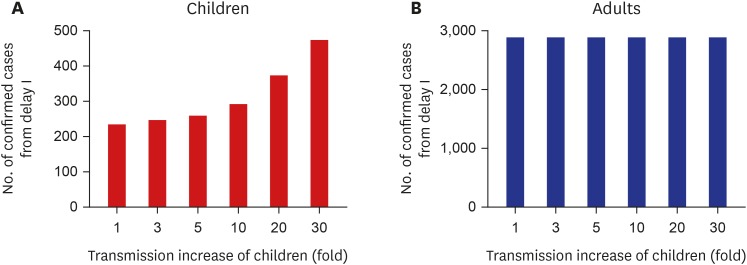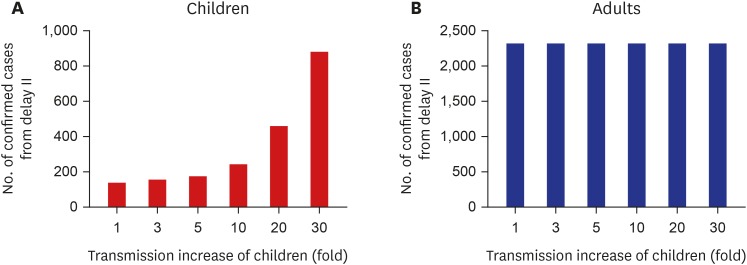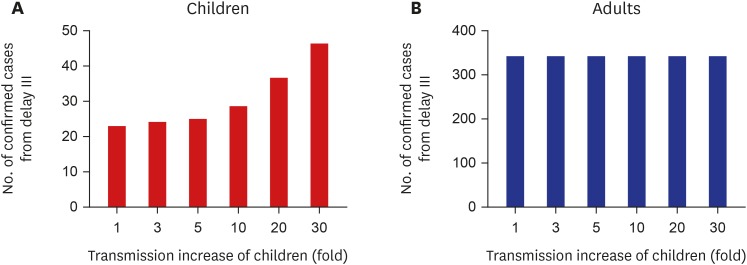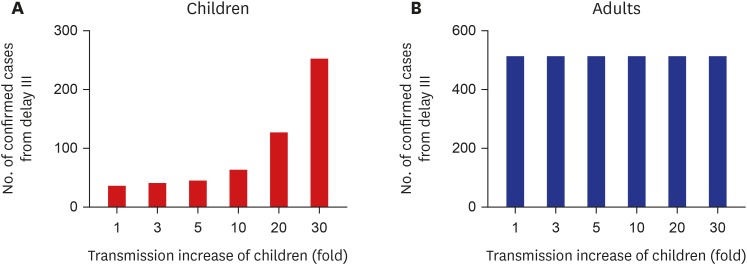School Opening Delay Effect on Transmission Dynamics of Coronavirus Disease 2019 in Korea: Based on Mathematical Modeling and Simulation Study
- Affiliations
-
- 1Department of Mathematics, Konkuk University, Seoul, Korea.
- 2Department of Pediatrics, Samsung Medical Center, Sungkyunkwan University School of Medicine, Seoul, Korea.
- 3Division of Infectious Diseases, Department of Medicine, Samsung Medical Center, Sungkyunkwan University School of Medicine, Seoul, Korea.
- KMID: 2509607
- DOI: http://doi.org/10.3346/jkms.2020.35.e143
Abstract
- Background
Nonpharmaceutical intervention strategy is significantly important to mitigate the coronavirus disease 2019 (COVID-19) spread. One of the interventions implemented by the government is a school closure. The Ministry of Education decided to postpone the school opening from March 2 to April 6 to minimize epidemic size. We aimed to quantify the school closure effect on the COVID-19 epidemic.
Methods
The potential effects of school opening were measured using a mathematical model considering two age groups: children (aged 19 years and younger) and adults (aged over 19). Based on susceptible-exposed-infectious-recovered model, isolation and behavior-changed susceptible individuals are additionally considered. The transmission parameters were estimated from the laboratory confirmed data reported by the Korea Centers for Disease Control and Prevention from February 16 to March 22. The model was extended with estimated parameters and estimated the expected number of confirmed cases as the transmission rate increased after school opening.
Results
Assuming the transmission rate between children group would be increasing 10 fold after the schools open, approximately additional 60 cases are expected to occur from March 2 to March 9, and approximately additional 100 children cases are expected from March 9 to March 23. After March 23, the number of expected cases for children is 28.4 for 7 days and 33.6 for 14 days.
Conclusion
The simulation results show that the government could reduce at least 200 cases, with two announcements by the Ministry of education. After March 23, although the possibility of massive transmission in the children's age group is lower, group transmission is possible to occur.
Figure
Cited by 4 articles
-
Social Distancing and Lessons from Sweden's Lenient Strategy against Corona Virus Disease 2019
Jin-Hong Yoo
J Korean Med Sci. 2020;35(27):e250. doi: 10.3346/jkms.2020.35.e250.Estimating the Effectiveness of Non-Pharmaceutical Interventions on COVID-19 Control in Korea
Kyung-Duk Min, Heewon Kang, Ju-Yeun Lee, Seonghee Jeon, Sung-il Cho
J Korean Med Sci. 2020;35(35):e321. doi: 10.3346/jkms.2020.35.e321.Stepwise School Opening and an Impact on the Epidemiology of COVID-19 in the Children
Yoonsun Yoon, Kyung-Ran Kim, Hwanhee Park, Soyoung Kim, Yae-Jean Kim
J Korean Med Sci. 2020;35(46):e414. doi: 10.3346/jkms.2020.35.e414.Multi-Faceted Analysis of COVID-19 Epidemic in Korea Considering Omicron Variant: Mathematical Modeling-Based Study
Youngsuk Ko, Victoria May Mendoza, Renier Mendoza, Yubin Seo, Jacob Lee, Jonggul Lee, Donghyok Kwon, Eunok Jung
J Korean Med Sci. 2022;37(26):e209. doi: 10.3346/jkms.2022.37.e209.
Reference
-
1. Korean Society of Infectious DiseasesKorean Society of Pediatric Infectious DiseasesKorean Society of EpidemiologyKorean Society for Antimicrobial TherapyKorean Society for Healthcare-associated Infection Control and PreventionKorea Centers for Disease Control and Prevention. Report on the Epidemiological features of coronavirus disease 2019 (COVID-19) outbreak in the Republic of Korea from January 19 to March 2, 2020. J Korean Med Sci. 2020; 35(10):e112. PMID: 32174069.2. KCDC Press. Daily Cumulative Confirmed Data. Cheongju: Korea Centers for Disease Control and Prevention;2020.3. Statistics Korea. Resident Registration Population by Administrative District and Age: Korean, Author's Translation. . Daejeon: Statistics Korea;2020.4. Towers S, Feng Z. Pandemic H1N1 influenza: predicting the course of a pandemic and assessing the efficacy of the planned vaccination programme in the United States. Euro Surveill. 2009; 14(41):19358. PMID: 19883540.
Article5. Kim S, Lee J, Jung E. Mathematical model of transmission dynamics and optimal control strategies for 2009 A/H1N1 influenza in the Republic of Korea. J Theor Biol. 2017; 412:74–85. PMID: 27769686.
Article6. Kucharski AJ, Russell TW, Diamond C, Liu Y, Edmunds J, Funk S, et al. Early dynamics of transmission and control of COVID-19: a mathematical modelling study. Lancet Infect Dis. 2020.
Article7. Fang Y, Nie Y, Penny M. Transmission dynamics of the COVID-19 outbreak and effectiveness of government interventions: as data-driven analysis. J Med Virol. 2020; jmv.25750.8. Choi SC, Ki M. Estimating the reproductive number and the outbreak size of Novel Coronavirus disease (COVID-19) using mathematical model in Republic of Korea. Epidemiol Health. 2020; e2020011. PMID: 32164053.9. Perra N, Balcan D, Gonçalves B, Vespignani A. Towards a characterization of behavior-disease models. PLoS One. 2011; 6(8):e23084. PMID: 21826228.
Article10. Korea Centers for Disease and Control. Korean Situation Report of COVID-19 on Feburary 16: Korean, Author's Translation. Cheongju: Korea Centers for Disease and Control;2020.11. Ki M. Task Force for 2019-nCoV. Epidemiologic characteristics of early cases with 2019 novel coronavirus (2019-nCoV) disease in Korea. Epidemiol Health. 2020; 42:e2020007. PMID: 32035431.
Article12. KOrean Statistical information Service. Statistics of Kindergarten (2019-11-12). Daejeon: Statistic Korea;2019.13. KOrean Statistical information Service. Statistics of Childcare by Age (2019-07-08). Daejeon: Statistics Korea;2019.14. KOrean Statistical information Service. Statistics of Elementry School (2019-11-13). Daejeon: Statistics Korea;2019.15. KOrean Statistical information Service. Statistics of Middle School (2019-11-13). Daejeon: Statistics Korea;2019.16. KOrean Statistical information Service. Statistics of High School (2019-11-13). Daejeon: Statistics Korea;2019.17. The MathWorks, Inc. MATLAB. https://kr.mathworks.com/products/matlab.html.
- Full Text Links
- Actions
-
Cited
- CITED
-
- Close
- Share
- Similar articles
-
- Mathematical Modeling of COVID-19 Transmission and Intervention in South Korea: A Review of Literature
- Modeling of transmission pathways on canine heartworm dynamics
- School closures during the coronavirus disease 2019 outbreak
- School Closures during Coronavirus Disease 2019 Outbreak
- The Characteristics of Middle Eastern Respiratory Syndrome Coronavirus Transmission Dynamics in South Korea









